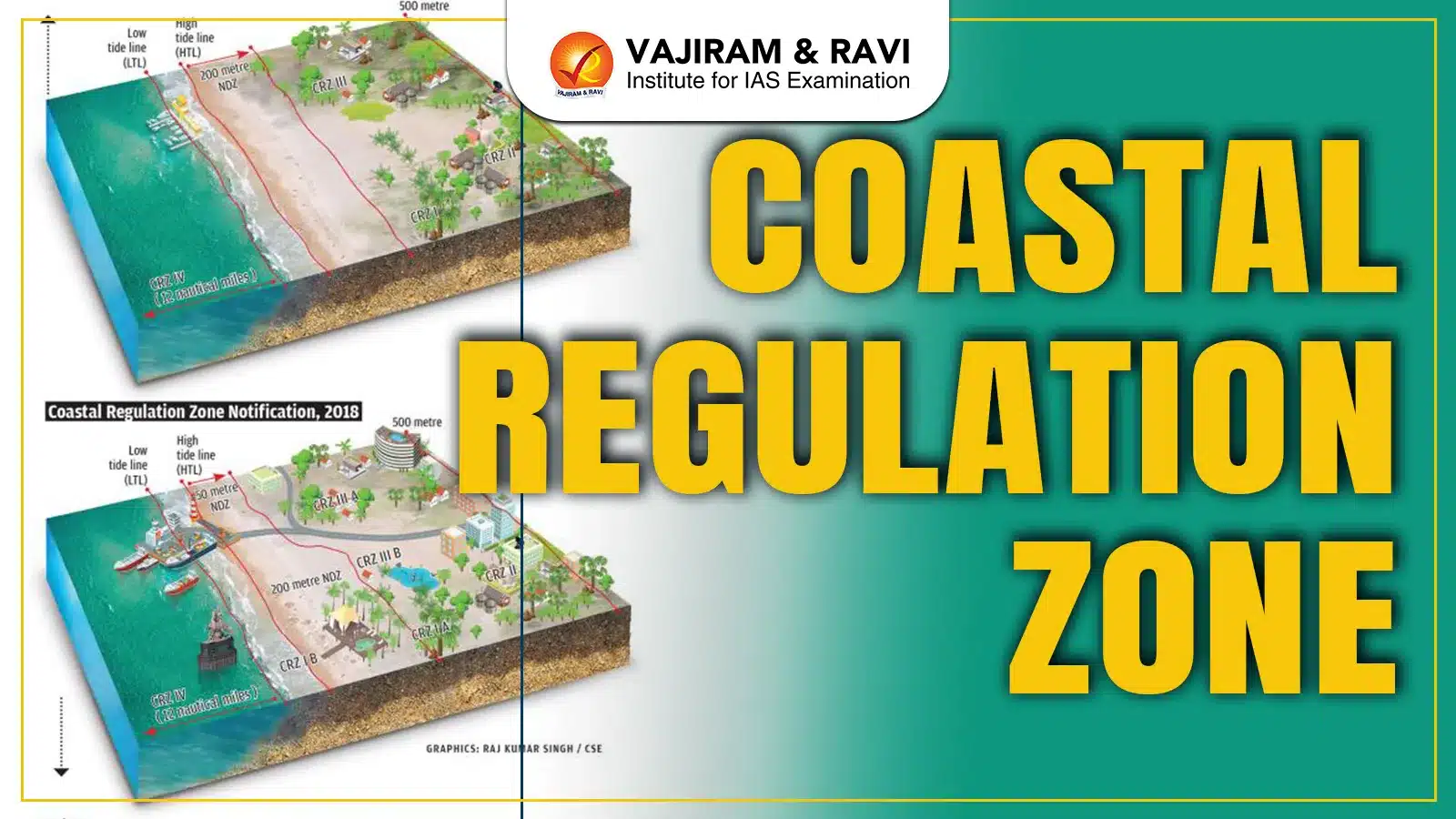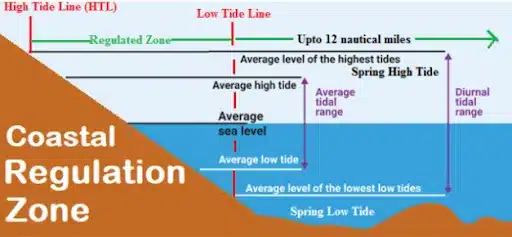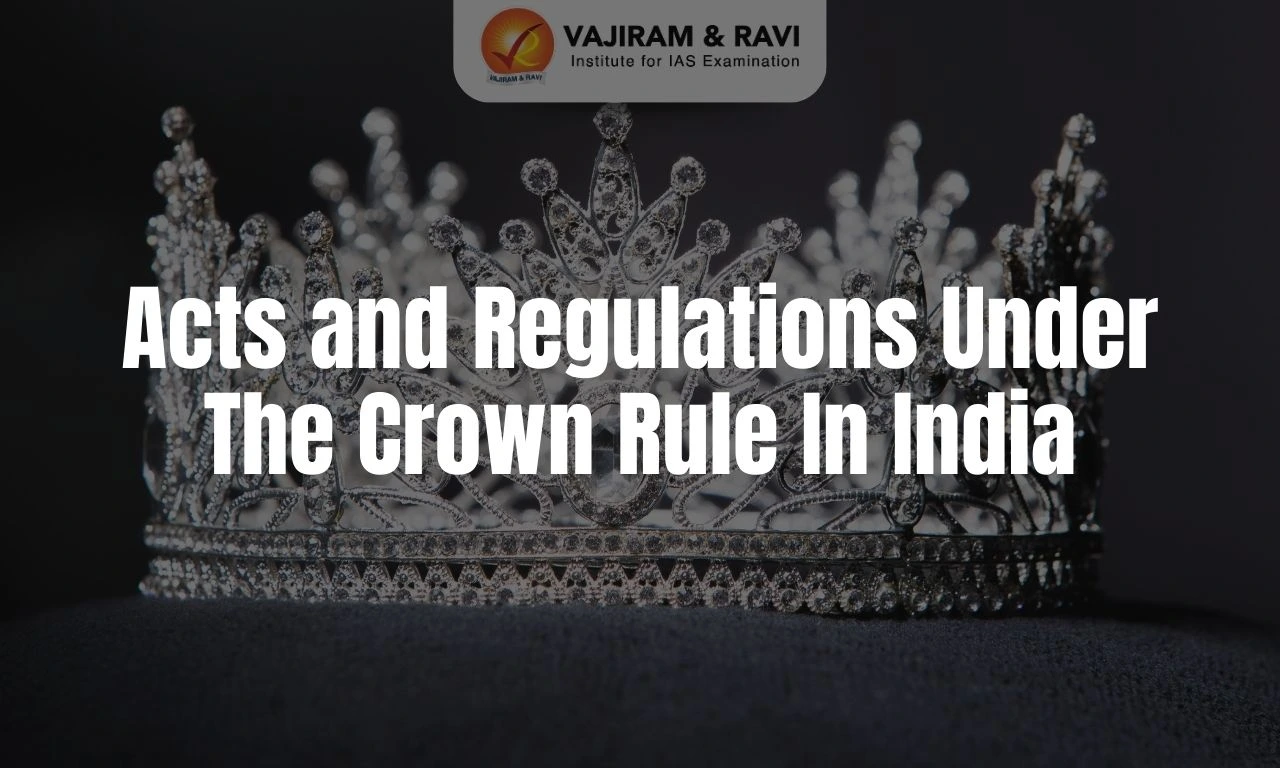Coastal Regulation Zone (CRZ), introduced under the Environment (Protection) Act, 1986, aims to safeguard India's coastal ecosystems while promoting sustainable development. It divides coastal areas into CRZ-I to CRZ-IV balancing environmental conservation with activities like fishing, tourism, and infrastructure development. Key updates in the 2019 notification reduced the No Development Zone (NDZ) and encouraged tourism in certain areas.
Challenges in CRZ implementation include poor enforcement, conflicting interests, and frequent amendments. In recent years, there have been debates and calls for reforming the CRZ rules to enable more development in coastal regions, but also to make sure the environment is not harmed.
Coastal Regulation Zone Meaning
Coastal Regulation Zone (CRZ) regulates activities along India's 7,516 km coastline to protect fragile ecosystems. The CRZ refers to the set of regulations enforced by the government of India to protect and conserve coastal areas and their ecosystems. These regulations are intended to balance development with environmental protection, especially in areas near the coastline.
- Under section 3 of Environment Protection Act, 1986 of India, Coastal Regulation Zone notification was issued in February 1991 for the first time, for regulation of activities in the coastal area by the Ministry of Environment and Forests (MoEF).
Coastal Regulation Zone Objective
Coastal Regulation Zone (CRZ) objective is to protect the fragile ecosystem, promote sustainable development, and ensure the well-being of coastal communities. The objectives of CRZ includes:
- Environmental Conservation: To preserve and protect the unique ecosystems of coastal areas and marine environments.
- Livelihood Security: To ensure the livelihood and well-being of fishing communities and other local populations residing in coastal regions.
- Sustainable Development: To encourage development activities based on scientific principles that promote long-term sustainability.
Coastal Regulation Zones Types
The Coastal Regulation Zone (CRZ) Notification was first issued by the Ministry of Environment, Forest and Climate Change (MoEFCC) in 1991, with subsequent amendments. It classifies the coastal areas into different zones, each with specific rules regarding what kind of development is permissible. The CRZ zones are classified as:
- These zones include CRZ-I (sensitive areas), CRZ-II (developed areas), CRZ-III (rural areas), and CRZ-IV (water bodies).
- Initially, the CRZ was categorized into four zones in 1991, which were retained in 2003. However, significant amendments were introduced in the CRZ Notification of 2011, and further modifications occurred in 2019.
CRZ-I (Ecologically Sensitive Areas)
- CRZ-I (A): Includes ecologically sensitive areas (ESAs) like mangroves, coral reefs, sand dunes, national parks, wildlife habitats, and areas of archaeological importance.
- CRZ-I (B): The intertidal zone between the Low Tide Line (LTL) and High Tide Line (HTL), extending up to 500 meters inland and up to 12 nautical miles seaward, covering tidal-influenced water bodies.
CRZ-II (Developed Areas)
Consists of developed land close to the shoreline within municipal limits, including drainage systems, roads, and other infrastructure.
CRZ-III (Rural Areas)
- CRZ-III (A): Densely populated areas (over 2161 people per sq. km) with a No Development Zone (NDZ) extending 50 meters from the HTL.
- CRZ-III (B): Less populated areas with an NDZ extending up to 200 meters from the HTL.
CRZ-IV (Water Areas)
- CRZ-IV (A): Water areas and seabed up to 12 nautical miles from the LTL on the seaward side.
- CRZ-IV (B): Water areas between the LTL on both sides of tidal-influenced water bodies.
Coastal Regulation Zones Notifications
The Coastal Regulation Zone (CRZ) Notifications regulate development along India's coastlines to protect the environment while supporting sustainable growth and coastal livelihoods. Key notifications were in 1991, 2011, and 2019.
- CRZ Notification 1991: This focused on regulating development activities along India's coast to prevent environmental degradation. CRZ Area Classification:
- CRZ-I: Ecologically sensitive areas.
- CRZ-II: Developed coastal regions.
- CRZ-III: Rural areas with No Development Zones (200 meters from HTL).
- CRZ-IV: Islands of Andaman & Nicobar and Lakshadweep.
- CRZ Notification of 2011: Aimed at ensuring sustainable development along India’s coastlines, protecting fisherfolk livelihoods, preserving coastal ecology, and promoting sustainable coastal development. CRZ Area Classification:
- CRZ-I: Ecologically sensitive areas.
- CRZ-II: Developed coastal areas.
- CRZ-III: Rural areas with No Development Zones. (Reduced to 100 meters for densely populated areas).
- CRZ-IV: Water areas up to 12 nautical miles.
- It also established Coastal Zone Management Authorities (CZMA) at the national, state, and district levels.
- CRZ Notification 2019: It focused on balancing economic development, particularly in the tourism and real estate sectors, with coastal zone conservation. CRZ Area Classification:
- CRZ-I: Divided into two subcategories:
- CRZ-I A: Ecologically Sensitive Areas (e.g., mangroves, coral reefs).
- CRZ-I B: Intertidal zones (between the Low Tide Line (LTL) and High Tide Line (HTL)).
- CRZ-II: Developed Urban Areas without further sub-classification.
- CRZ-III: Rural coastal areas, divided into:
- CRZ-III A: Densely populated rural areas (population ≥ 2,161 people/sq km); reduced No Development Zone (NDZ) to 50 meters from HTL.
- CRZ-III B: Less populated rural areas with a 200-meter NDZ.
- CRZ-IV: Water areas, divided into:
- CRZ-IV A: Water areas up to 12 nautical miles from the LTL on the seaward side.
- CRZ-IV B: Water and tidal-influenced areas between banks.
- CRZ-I: Divided into two subcategories:
Coastal Regulation Zone Permissible Activities
The Coastal Regulation Zone (CRZ) permits activities like eco-tourism, construction, and fishing while ensuring environmental safeguards. Permissible activities vary by zone to balance development with coastal protection. The detailed explanation is given below:
- CRZ-I A (Ecologically Sensitive Areas)
- Limited eco-tourism activities (mangrove walks, nature trails, etc.).
- Public utilities (pipelines, transmission lines, roads on stilts).
- Exceptional construction for defense, strategic purposes with EIA, and compensatory mangrove planting.
- CRZ-I B (Intertidal Areas)
- Permissible for foreshore facilities (ports, jetties, erosion control).
- Defense, strategic projects, pipelines, and weather monitoring.
- CRZ-II
- Construction for residential, schools, hospitals, and public places is allowed on the landward side of existing roads or fixed structures.
- Buildings must comply with the Floor Space Index (FSI)/FAR regulations as per the town and country planning norms prevailing at the time of the notification.
- CRZ-III (No Development Zone (NDZ)
- No construction except for repairs/reconstruction of existing authorized structures without exceeding FSI or plinth area.
- Beyond the NDZ, beach resorts and tourism development are subject to guidelines and environmental safeguards.
- CRZ-IV (Water Area)
- Traditional fishing and related activities are permitted.
- Foreshore facilities, offshore wind power, and exploration/extraction of natural resources are allowed.
Coastal Regulation Zone Prohibited Activities
CRZ regulations restrict industrial activities, land reclamation, and waste disposal in coastal areas while allowing certain activities like fish processing with prior approval. The detailed explanation is given below:
- Industrial Development Restrictions: New industries and expansion of existing industries or processes are prohibited in CRZ areas, except those requiring waterfront access with prior permission.
- Fish Processing Units: Setting up of new fish processing units is allowed but requires approval from the competent authorities.
- Land Reclamation: Reclamation of land, bunding, or disturbing the natural flow of seawater is not permitted, except with prior approval for permissible activities under the notification.
- Waste Discharge: Discharge of untreated waste and effluents from industries, cities, towns, or human settlements into coastal waters is strictly prohibited.
- Solid Waste Dumping: Dumping of city or town wastes, including construction debris, industrial solid wastes, and fly ash for landfilling, is not allowed.
- Plastic Disposal: Disposal of plastic into coastal waters is prohibited, with adequate management and disposal measures required for plastic materials in CRZ areas.
Coastal Regulation Zone Clearance Procedures
The procedure for obtaining clearances under the Coastal Regulation Zone (CRZ) Notification, 2019 involves several key steps to ensure that development activities along India's coastline are environmentally sustainable.
- CRZ-I & IV: Clearances are granted by the Ministry of Environment, Forest and Climate Change (MoEFCC).
- CRZ-II & III: Clearances are handled by the respective State Coastal Zone Management Authorities (SCZMAs).
Coastal Regulation Zone Significance
The Coastal Regulation Zone (CRZ) safeguards coastal ecosystems from urbanization, pollution, and climate change impacts, acting as an ecological buffer. It ensures livelihood security for coastal communities while promoting sustainable development and resilience. The detailed explanation is given below:
- Environmental Protection: CRZ acts as an ecologically sensitive buffer zone, safeguarding coastal ecosystems from anthropogenic interventions and climate change impacts like urbanization, pollution, and coastal erosion.
- Livelihood Security: It prioritizes the interests of coastal communities, ensuring their traditional rights and access to resources are protected.
- Sustainable Development: CRZ promotes sustainable development by balancing economic activities with environmental conservation.
- Climate Change Mitigation: It addresses climate change impacts and natural hazards, supporting resilience in coastal areas.
Coastal Regulation Zone Challenges
The implementation of CRZ regulations faces challenges such as poor enforcement, conflicting interests, and frequent amendments, which can undermine environmental protection. The detailed explanation is given below:
- Implementation Issues: Poor enforcement and lack of adequate machinery hinder effective implementation, leading to widespread violations.
- Conflicting Interests: Balancing economic development with environmental protection often results in conflicts among stakeholders.
- Amendments and Relaxations: Frequent amendments can dilute environmental protections, raising concerns about coastal degradation.
- Community Concerns: Coastal communities may face displacement or loss of livelihoods due to CRZ regulations.
Shailesh Nayak Committee Report on CRZ
Sailesh Nayak Committee on CRZ was formed to review the issues relating to Coastal Regulation Zone, 2011. The Recommendations of the committee include reducing the No Development Zone in rural areas, allowing tourism development, and decentralizing coastal management. The main recommendations are as follows:
- Reduction of 'No Development Zone' (NDZ): It proposed reducing NDZ to 50m from the High Tide Line (HTL) in rural areas with a population density greater than 2,161 people per square kilometer.
- NDZ should remain 200 meters from the HTL in all other areas.
- Tourism Development: Recommended permitting the construction of tourism facilities and related infrastructure inside the NDZ to encourage tourism.
- Decentralization of Power: Proposed to devolve more powers to local, state, and union territory governments for better coastal management.
- Ecologically Sensitive Areas (ESA): Suggested identifying ESAs like mangroves, beaches, and coral reefs under CRZ I. Recommended states and UTs to notify these areas under the Environment Protection Act, 1986, and create Coastal Zone Management Plans (CZMPs).
- Reclamation of Seabed Areas: Recommends permitting seabed reclamation in CRZ IV for infrastructure like ports, fisheries, bridges, and national security installations in the public interest.
- Housing and Infrastructure Development: Proposed allowing housing infrastructure, slum development, ports, and tourism-related construction within CRZ zones.
Many of the recommendations from the Shailesh Nayak Committee Report were accepted, but with certain modifications and implemented in phases.
Coastal Regulation Zone Way Forward
The way ahead for CRZ management includes integrating technology, streamlining clearances, and prioritizing ecological conservation, with improved coordination between central and state authorities. The detailed explanation is given below:
- Technology Integration: Leverage technology and involve local communities in decision-making processes to enhance resilience and sustainability.
- Streamlined Clearance Processes: Simplify CRZ clearance procedures to facilitate sustainable development while maintaining environmental safeguards.
- Ecological Conservation: Prioritize ecological conservation by maintaining no-development zones and regulating pollution.
- Policy Reforms: Enhance coordination between central and state authorities to streamline policy implementation. It is crucial for effective coastal zone management.
Coastal Regulation Zone UPSC PYQs
Q1. Explain the causes and effects of coastal erosion in India. What are the available coastal management techniques for combating the hazard? (UPSC Mains 2022)
Last updated on December, 2025
→ Check out the latest UPSC Syllabus 2026 here.
→ Join Vajiram & Ravi’s Interview Guidance Programme for expert help to crack your final UPSC stage.
→ UPSC Mains Result 2025 is now out.
→ UPSC Notification 2026 is scheduled to be released on January 14, 2026.
→ UPSC Calendar 2026 is released on 15th May, 2025.
→ The UPSC Vacancy 2025 were released 1129, out of which 979 were for UPSC CSE and remaining 150 are for UPSC IFoS.
→ UPSC Prelims 2026 will be conducted on 24th May, 2026 & UPSC Mains 2026 will be conducted on 21st August 2026.
→ The UPSC Selection Process is of 3 stages-Prelims, Mains and Interview.
→ UPSC Result 2024 is released with latest UPSC Marksheet 2024. Check Now!
→ UPSC Prelims Result 2025 is out now for the CSE held on 25 May 2025.
→ UPSC Toppers List 2024 is released now. Shakti Dubey is UPSC AIR 1 2024 Topper.
→ UPSC Prelims Question Paper 2025 and Unofficial Prelims Answer Key 2025 are available now.
→ UPSC Mains Question Paper 2025 is out for Essay, GS 1, 2, 3 & GS 4.
→ UPSC Mains Indian Language Question Paper 2025 is now out.
→ UPSC Mains Optional Question Paper 2025 is now out.
→ Also check Best IAS Coaching in Delhi
Coastal Regulation Zone FAQs
Q1. What is the concept of Coastal Regulation Zone?+
Q2. What is the CRZ zone in India?+
Q3. What are the CRZ 3 rules?+
Q4. What is the CRZ Act in India?+
Q5. What does CRZ stand for?+
Tags: coastal regulation zone quest UPSC Environment and Ecology Notes


















